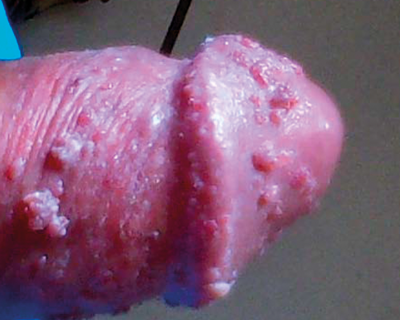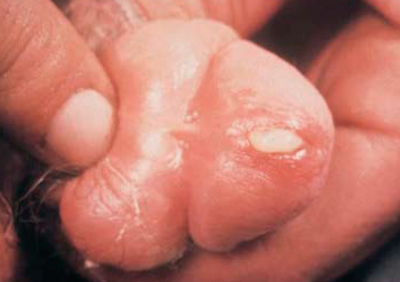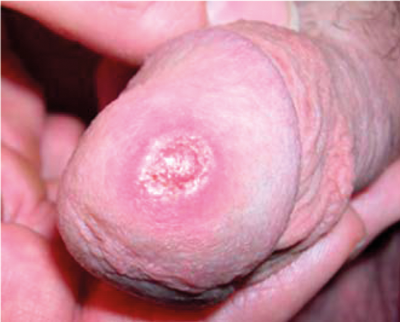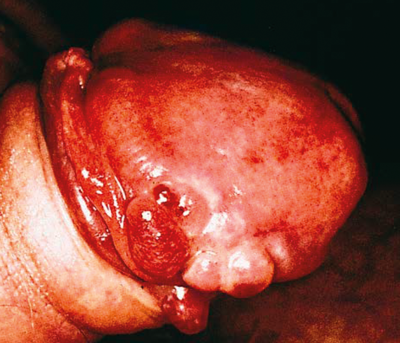Case 1
A 27-year-old man presents to the clinic with multiple asymptomatic penile lesions.

1. What is the diagnosis?
2. What are the likely pathogens which cause these lesions?
3. What treatment options are available to treat these lesions?
4. Can such lesions be prevented?
Case 2
A 35-year-old man had unprotected intercourse whilst on holiday in South East Asia. He has developed urethritis and his clinical examination is shown.

1. What are the infective organisms that may give this appearance??
2. How would you confirm the clinic diagnosis?
3. What other tests might be considered?
4. At first presentation, what treatment would you start whilst waiting for cultures and why?
Case 3
A patient noted this lesion in figure 1. It was asymptomatic and non-purulent.

Figure 1.

Figure 2.
1. What is the likely cause of this?
2. The patient did not seek medical advice and his lesion settled after a few weeks. He later presented to his GP with a rash on his hands and feet (Figure 2). What is the likely cause of this?
3. What other manifestations can this STI cause if untreated?
4. What is the causative organism and standard treatment?
Case 4
A 45-year-old male with known HIV presents with the lesion below.

1. What is the likely diagnosis?
2. What are the urological manifestations of HIV infection?
Answers
Case 1
-
Penile warts – condyloma acuminatum.
-
HPV 6 and 11 – cause 90% of genital warts.
-
Topical therapy (usually three months): 5% Imiquimod, cryotherapy, laser ablation or surgical excision / curettage or electrosurgery.
-
Yes. Safe sex with condoms and the HPV vaccine: Gardasil. Vaccine now against nine strains of HPV (Types 6 and 11 (warts), Type 16 and 18 (cervical / penile cancers), plus types 31, 33, 45, 52 and 58).
Case 2
-
Chlamydia trachomatis, Neisseria gonorrhoeae, ureaplasma urealyticum, mycoplasma genitalium and adenovirus.
-
First pass urine for PCR or urethral swab for culture (only way to get sensitivities).
-
Syphilis and HIV testing.
-
Most likely chlamydia and / or gonorrhea. Therefore start empirical treatment to cover both. Ceftriaxone 250mg IM (gonorrhoea) and doxycycline 100mg BD for seven days or azithromycin 1g one dose (chlamydia).
Case 3
-
Syphilis – chancre (painless, punched out lesions).
-
Macular – papular rash on palms and soles of feet commonly seen in secondary syphilis.
-
Neurosyphilis: tabes dorsalis, lightening pains, paresis, Argyll Robertson pupil (accomodating to focus on a near object but non-reactive to light). Cardiovascular syphilis: aortitis, aortic valve insufficiency and abdominal aortic aneurysms (AAA).
-
Treponema pallidum (spirochete). Benzathine penicillin G IM, single dose.
Case 4
-
Kaposi sarcoma.
-
Haematuria, HIV associated nephropathy, infections – kidney / bladder / prostate / testes, malignancy – testes / penis, stones – indinavir, erectile dysfunction, voiding dysfunction / LUTS, fistulas secondary to lymphoma / anal carcinoma / infertility.




